In the coastal regions of Japan, tales of the mysterious Nurarihyon have passed through generations, shrouded in myth and fear. Known as the master of disguise and the leader of the Yokai—a group of supernatural beings in Japanese folklore—the Nurarihyon is a creature that embodies both cunning and charm. He slips into homes undetected, assumes the role of the master, and seamlessly takes control. His presence unsettles even the bravest, yet his true nature remains elusive. In the early days of the Edo period, on a misty morning, the fishing village of Fukagawa stirred with rumors of strange sightings. Fishermen spoke in hushed tones of a figure seen walking along the shore, appearing from the sea fog, only to vanish like a specter. On that particular morning, the village elder, Sato, sat in front of his small shrine, watching the fog roll in. He had lived through enough seasons to sense when something unusual was about to occur. The air was too quiet, the sea too still. As he stared out at the fog, a shadow emerged. Sato squinted, trying to make out the figure. It was a man, or at least, it appeared to be. Dressed in a silk robe that shimmered even in the pale morning light, he moved with an unnerving calmness. His head was oddly shaped, elongated at the top, like a gourd. “Who is that?” Sato whispered to himself. The figure walked directly toward Sato’s house, his eyes glinting under the wide brim of a peculiar hat. Sato stood to greet him, but before he could say a word, the figure smiled and nodded as though they were old friends. Without a word, the stranger entered Sato’s home, walking into the kitchen as though he owned it. The elder watched, speechless, as the man made himself comfortable, pouring tea and reclining on the floor mats. He acted as if he were the master of the house, with such authority that Sato, too stunned to protest, simply sat back down. After some moments, the stranger gave a curt nod, stood up, and left just as silently as he had come. The village would soon discover that this was no ordinary man. It was the Nurarihyon—an enigmatic figure from the realm of yokai—who had come to live among them. The village quickly became uneasy. Families began noticing strange occurrences—items moved around, food missing, and rooms rearranged—all without any sign of forced entry. Women would prepare meals, only to find that a guest had helped himself before anyone else had sat at the table. Some of the villagers began whispering that the Nurarihyon had taken residence in Fukagawa. Sato, who had already witnessed the mysterious guest’s arrival, was not one to be easily swayed by superstition. But even he found it impossible to dismiss what he had seen with his own eyes. The figure had entered his home like a ghost, left no trace, and carried an air of command that Sato had never seen before. Word reached the village priest, Kojiro, who was known for his wisdom in dealing with the supernatural. He believed the village had been visited by something far more sinister than a mere wandering soul. Kojiro began investigating, gathering the villagers for counsel and seeking ways to rid them of this unsettling presence. “Nurarihyon,” Kojiro explained to the gathered villagers one evening, “is no ordinary yokai. He does not harm, but he plays with the minds of men. He can take control of your very home, and you’ll let him do it. The danger lies in his deception. If we allow him to settle here, we may never be rid of him.” The villagers listened, their eyes wide with fear. The idea that such a powerful entity could simply walk into their homes, assume control, and leave them feeling powerless was enough to cause sleepless nights across the village. As days passed, Kojiro devised a plan to confront the Nurarihyon. They would offer him a grand feast, inviting him as the guest of honor, and then use sacred charms to banish him from the village forever. On the night of the feast, the entire village prepared the finest food and drink they could muster. Tables overflowed with rice, grilled fish, and fragrant bowls of miso soup. Sake bottles lined the tables, their contents glistening in the torchlight. It was a night of celebration, but beneath the surface, the tension was palpable. This was no ordinary feast; it was a trap. Sato, Kojiro, and several other villagers waited nervously for their guest to arrive. They sat around the low table, watching the door, waiting for that familiar, unsettling figure to appear. And then, as if summoned by the weight of their collective fear, the Nurarihyon entered. He moved with the same eerie grace as before, his robes trailing lightly behind him. His head, still resembling a gourd, tilted slightly as he surveyed the room. Without hesitation, he took a seat at the center of the feast, smiling faintly as he began to eat. Kojiro signaled to the other villagers. Slowly, they began to circle the table, holding charms and murmuring prayers under their breath. But the Nurarihyon only chuckled. “Do you think you can cast me out so easily?” he said, his voice low and velvety. “I am no mere spirit. I am Nurarihyon, master of the Yokai. This village is now under my protection.” Kojiro’s hands trembled as he tightened his grip on the sacred charm. But before he could take another step, the Nurarihyon vanished—leaving nothing but an empty seat and the lingering scent of incense. That night, the villagers were left with more questions than answers. How could they banish something that could disappear at will? How could they fight a being that seemed to exist both in their world and beyond it? Weeks passed, and the village settled into an uneasy calm. The Nurarihyon no longer made his presence known as often, but the villagers knew he was still there, lurking in the shadows, watching their every move. One evening, as Sato sat alone in his home, pondering the events of the past months, a realization struck him. The Nurarihyon had not come to harm them. He had, in his own way, claimed the village as his domain, but he had not destroyed it. In fact, since his arrival, strange as it was, the village had prospered. The harvest had been plentiful, and the fishermen had brought in more catches than ever before. Sato decided to seek out the Nurarihyon himself. If he could understand this yokai’s true purpose, perhaps there could be a way for the village to coexist with him. That night, Sato ventured to the edge of the forest, where the fog was thickest. He called out into the mist, “Nurarihyon, I seek your counsel.” At first, there was only silence. But then, the familiar figure appeared, stepping out of the mist as if he had been there all along. “You are bold, Sato,” the Nurarihyon said, his voice smooth and commanding. “Few would seek me out willingly.” “I wish to understand,” Sato replied. “Why have you come to our village?” The Nurarihyon smiled. “I come where I am needed. Your village was weak, divided by fear and superstition. My presence brings order. You feared me, but I did not harm you. I only took what was freely given.” Sato bowed his head, considering the words carefully. “Then, if we do not resist, you will not bring us harm?” The Nurarihyon laughed softly. “You have nothing to fear, old man. Let me guide your village, and it will thrive. But remember, I am not to be trifled with. Respect me, and you shall live in peace.” With that, the Nurarihyon vanished once again into the fog. The next morning, Sato gathered the villagers and relayed his encounter with the Nurarihyon. Some were skeptical, while others feared the idea of allowing a yokai to have such control over their lives. But Sato assured them that the Nurarihyon had no intention of causing harm—so long as they respected his presence. The villagers, tired of living in fear, reluctantly agreed to a silent pact. They would no longer attempt to banish the Nurarihyon, but instead, they would coexist with him. They would offer him a place at their feasts, acknowledge his unseen presence, and in return, he would protect their village from harm. From that day forward, the Nurarihyon became an invisible guardian of the village. Though he was rarely seen, his influence was always felt. The village prospered under his watchful eye, and the people grew to accept that their unusual protector was not an enemy, but a part of their lives. As time passed, the stories of the Nurarihyon spread beyond Fukagawa. Other villages heard of the mysterious yokai who could control homes and lives with such ease. Some believed the tale, while others dismissed it as mere folklore. But in Fukagawa, they knew the truth. Years passed, and Sato grew old. His hair turned white, and his steps grew slower, but he remained the village elder, respected by all. He often thought of the Nur arihyon and wondered if the yokai still watched over them from the shadows. One misty morning, much like the day the Nurarihyon first arrived, Sato sat outside his home, gazing at the sea. The fog was thick, and the air was still. Suddenly, a familiar figure emerged from the mist—Nurarihyon, unchanged by time, his robes billowing softly in the wind. “You’ve come,” Sato said, smiling faintly. “I have,” the Nurarihyon replied. “It is time for me to move on.” Sato nodded, understanding that the village no longer needed the yokai’s protection. They had grown strong and united, no longer bound by fear or superstition. “You have served us well,” Sato said, bowing deeply. “And you, old man, have been a wise leader,” the Nurarihyon replied. “But remember, I will always be watching.” With that, the Nurarihyon turned and walked back into the mist, disappearing from sight. The village never saw him again, but his legend lived on.The Mysterious Arrival
The Rise of Suspicion
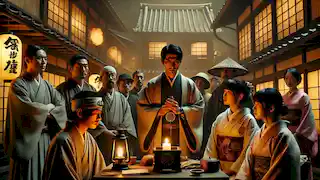
The Feast of Confrontation
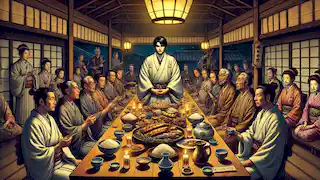
The Elder’s Revelation
The Village's Pact
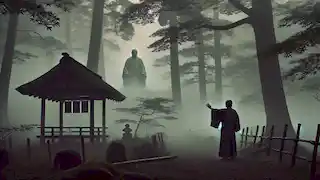
The Last Visit
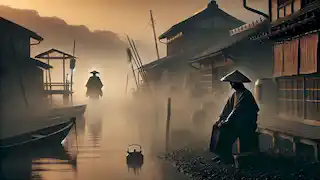
The Legend of the Nurarihyon
Reading Time: 9 min
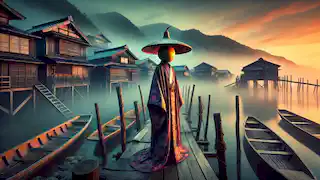
About Story: The Legend of the Nurarihyon is a Legend Stories from japan set in the Medieval Stories. This Descriptive Stories tale explores themes of Courage Stories and is suitable for All Ages Stories. It offers Cultural Stories insights. The mysterious yokai who controls the lives of an unsuspecting village.

















